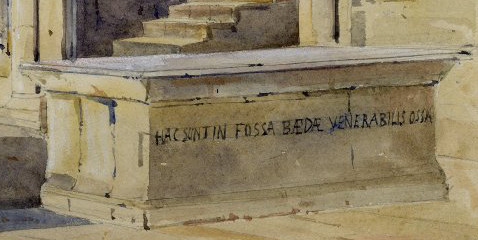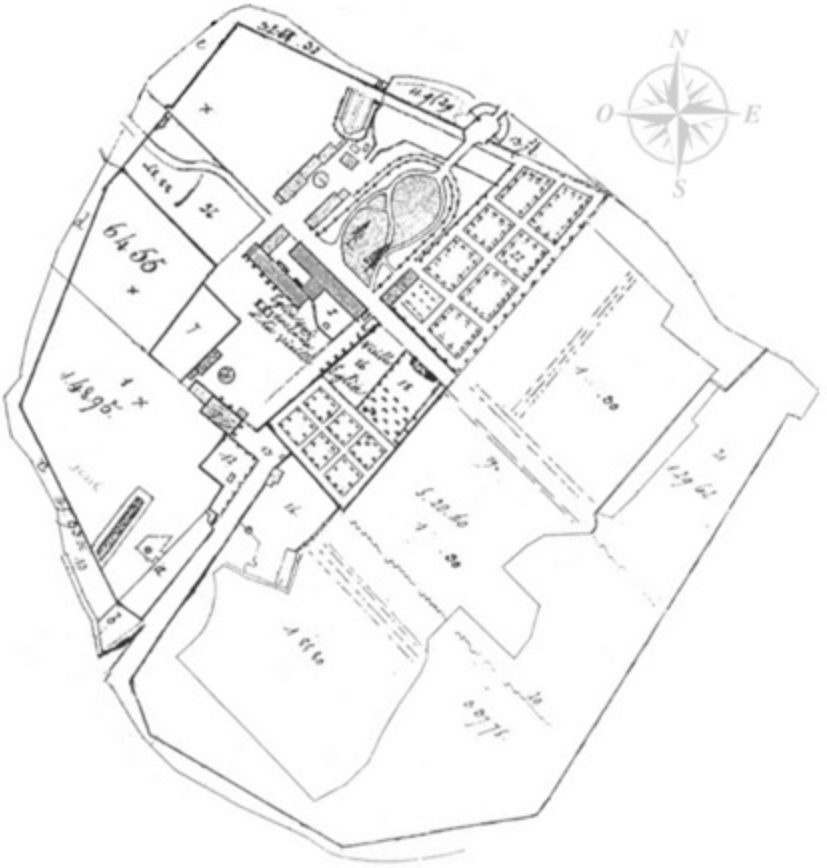|
Linquo Coax Ranis
''Linquo coax ranis'' are the first words of a two-line poem in internally rhymed hexameters by Serlo of Wilton. The complete text is: :''Linquo coax ranis, cras corvis, vanaque vanis; :Ad logicam pergo que mortis non timet ergo.'' :I leave croaking to frogs, crowing to crows, and vanity to the vain; :I now go to the logic that does not fear the ''conclusion'' of death. Attached to the poem is a story (which may be compared with the razós attached to certain Occitan poems of the 12th and 13th centuries). The earliest known version of the story, in Latin, forms part of a manuscript collection, ''Liber narrationum de diversis visionibus et miraculis'', which itself is part of MS. Troyes 946 from the Abbey of Clairvaux collection. This version was written at some date after 1173, when Serlo became abbot of L'Aumône Abbey, and before 1181, the year of his death. According to the story, one of Serlo's disciples, who had died young, appeared to him in a vision. He was wearing a pa ... [...More Info...] [...Related Items...] OR: [Wikipedia] [Google] [Baidu] |
Leonine Verse
Leonine verse is a type of versification based on internal rhyme, and commonly used in Latin verse of the European Middle Ages. The invention of such conscious rhymes, foreign to Classical Latin poetry, is traditionally attributed to a probably apocryphal monk Leonius, who is supposed to be the author of a history of the Old Testament (''Historia Sacra'') preserved in the Bibliothèque Nationale of Paris. This "history" is composed in Latin verses which rhyme in the center. It is possible that this Leonius is the same person as Leoninus, a Benedictine musician of the twelfth century, in which case he would not have been the original inventor of the form. It is sometimes referred to disparagingly as "jangling verse" by classical purists, for example 19th century antiquaries, who consider it absurd and coarse and a corruption of and offensive to the high ideals of classical literature. In English, the rhyme may be between a word within the line (often before a caesura) and the word ... [...More Info...] [...Related Items...] OR: [Wikipedia] [Google] [Baidu] |
Serlo Of Wilton
Serlo of Wilton ( 1105–1181) was a 12th-century English poet, a friend of Walter Map and known to Gerald of Wales.Gerald of Wales, '' Speculum Ecclesiae'' 2.33. He studied and taught at the University of Paris. He became a Cluniac and then a Cistercian monk, and in 1171 he became abbot of L'Aumône Abbey, a Cistercian monastery between Chartres and Blois. He died in 1181. Serlo's poems are in Latin, of which the most famous is ''Linquo coax ranis''. He is the subject of an 1899 essay by the French author Marcel Schwob Mayer André Marcel Schwob, known as Marcel Schwob (23 August 1867 – 26 February 1905), was a French symbolist writer best known for his short stories and his literary influence on authors such as Jorge Luis Borges, Alfonso Reyes, Roberto Bol ..., ''La légende de Serlon de Wilton''. Notes Bibliography * * * * * {{authority control Cluniacs Medieval Latin poets 12th-century Latin writers 12th-century births 1181 deaths English male poets 12th ... [...More Info...] [...Related Items...] OR: [Wikipedia] [Google] [Baidu] |
Razó (Occitan Literary Form)
A ''razo'' (, literally "cause", "reason") was a short piece of Occitan prose detailing the circumstances of a troubadour composition. A ''razo'' normally introduced an individual poem, acting as a prose preface and explanation; it might, however, share some of the characteristics of a '' vida'' (a biography of a troubadour, describing his origins, his loves, and his works) and the boundary between the two genres was never sharp. In the ''chansonniers'', the manuscript collections of medieval troubadour poetry, some poems are accompanied by a prose explanation whose purpose is to give the reason why the poem was composed. These texts are occasionally based on independent sources. To that extent, they supplement the ''vidas'' in the same manuscripts and are useful to modern literary and historical researchers. Often, however, it is clear that assertions in the ''razos'' are simply deduced from literal readings of details in the poems. Most of the surviving ''razo'' corpus is the wo ... [...More Info...] [...Related Items...] OR: [Wikipedia] [Google] [Baidu] |
Latin Language
Latin (, or , ) is a classical language belonging to the Italic branch of the Indo-European languages. Latin was originally a dialect spoken in the lower Tiber area (then known as Latium) around present-day Rome, but through the power of the Roman Republic it became the dominant language in the Italian region and subsequently throughout the Roman Empire. Even after the fall of Western Rome, Latin remained the common language of international communication, science, scholarship and academia in Europe until well into the 18th century, when other regional vernaculars (including its own descendants, the Romance languages) supplanted it in common academic and political usage, and it eventually became a dead language in the modern linguistic definition. Latin is a highly inflected language, with three distinct genders (masculine, feminine, and neuter), six or seven noun cases (nominative, accusative, genitive, dative, ablative, and vocative), five declensions, four verb ... [...More Info...] [...Related Items...] OR: [Wikipedia] [Google] [Baidu] |
Troyes
Troyes () is a commune and the capital of the department of Aube in the Grand Est region of north-central France. It is located on the Seine river about south-east of Paris. Troyes is situated within the Champagne wine region and is near to the Orient Forest Regional Natural Park. Troyes had a population of 61,996 inhabitants in 2018. It is the center of the agglomeration community Troyes Champagne Métropole, which was home to 170,145 inhabitants. Troyes developed as early as the Roman era, when it was known as Augustobona Tricassium. It stood at the hub of numerous highways, primarily the Via Agrippa. The city has a rich historical past, from the Tricasses tribe to the liberation of the city on 25 August 1944 during the Second World War, including the Battle of the Catalaunian Plains, the Council of Troyes, the marriage of Henry V and Catherine of France, and the Champagne fairs to which merchants came from all over Christendom. The city has a rich architectural and ... [...More Info...] [...Related Items...] OR: [Wikipedia] [Google] [Baidu] |
Abbey Of Clairvaux
Clairvaux Abbey (, ; la, Clara Vallis) was a Cistercian monastery in Ville-sous-la-Ferté, from Bar-sur-Aube. The original building, founded in 1115 by St. Bernard, is now in ruins; the present structure dates from 1708. Clairvaux Abbey was a good example of the general layout of a Cistercian monastery. The abbey has been listed since 1926 as a historical monument by the French Ministry of Culture. The grounds are now occupied and used by Clairvaux Prison, a high-security prison. History In 1115 Bernard, a Benedictine monk of the Abbaye de Saint-Nicolas-lès-Cîteaux, was sent with a group of twelve other monks to found a new house at Vallée d'Absinthe. Hughes I, Count of Troyes, donated this valley to the colony of Cistercians.Gildas, Marie. "Abbey of Clairvaux." The Catholic Encyclopedia [...More Info...] [...Related Items...] OR: [Wikipedia] [Google] [Baidu] |
L'Aumône Abbey
L’Aumône Abbey (french: Abbaye Notre-Dame de l’Aumône, la, Eleemosynae; also known as french: Petit-Cîteaux, la, Cistercium minus) is a former Cistercian monastery in the commune of La Colombe, Loir-et-Cher, France, 34 kilometres north of Blois in the Forêt de Cîteaux, part of the Forêt de Marchenoir. History The abbey was founded in 1121, thanks to a gift from Count Theobald IV of Blois, as the seventh daughter house of Cîteaux Abbey. It became the mother house of 29 abbeys, including Waverley Abbey in England (the first Cistercian foundation in the British Isles), Bégard Abbey, Tintern Abbey, Langonnet Abbey and Le Landais Abbey. The abbey suffered greatly during the Hundred Years' War and by 1396 lay mostly in ruins. The subsequent reconstruction and the introduction of commendatory abbots proved a serious burden. The abbey was suppressed in 1791 during the French Revolution. The land was sold in 1818 and the debris from the ruins was used as building mat ... [...More Info...] [...Related Items...] OR: [Wikipedia] [Google] [Baidu] |
Cistercian Order
The Cistercians, () officially the Order of Cistercians ( la, (Sacer) Ordo Cisterciensis, abbreviated as OCist or SOCist), are a Catholic religious order of monks and nuns that branched off from the Benedictines and follow the Rule of Saint Benedict, as well as the contributions of the highly-influential Saint Bernard of Clairvaux, known as the Latin Rule. They are also known as Bernardines, after Saint Bernard himself, or as White Monks, in reference to the colour of the "cuculla" or cowl (choir robe) worn by the Cistercians over their habits, as opposed to the black cowl worn by Benedictines. The term ''Cistercian'' derives from ''Cistercium,'' the Latin name for the locale of Cîteaux, near Dijon in eastern France. It was here that a group of Benedictine monks from the monastery of Molesme founded Cîteaux Abbey in 1098, with the goal of following more closely the Rule of Saint Benedict. The best known of them were Robert of Molesme, Alberic of Cîteaux and the Engl ... [...More Info...] [...Related Items...] OR: [Wikipedia] [Google] [Baidu] |
Marcel Schwob
Mayer André Marcel Schwob, known as Marcel Schwob (23 August 1867 – 26 February 1905), was a French symbolist writer best known for his short stories and his literary influence on authors such as Jorge Luis Borges, Alfonso Reyes, Roberto Bolaño and Patricio Pron. He has been called a "precursor of Surrealism". In addition to over a hundred short stories, he wrote journalistic articles, essays, biographies, literary reviews and analysis, translations and plays. He was extremely well known and respected during his life and notably befriended a great number of intellectuals and artists of the time. Early life (1867–89) He was born in Chaville, Hauts-de-Seine on 23 August 1867 into a cultivated Jewish family. His father, George Schwob, was a friend of Théodore de Banville and Théophile Gautier. His mother, Mathilde Cahun, came from a family of intellectuals from Alsace. He was the brother of Maurice Schwob and uncle of Claude Cahun (born Lucy Schwob). His family had just ... [...More Info...] [...Related Items...] OR: [Wikipedia] [Google] [Baidu] |
12th-century Latin Literature
1 (one, unit, unity) is a number representing a single or the only entity. 1 is also a numerical digit and represents a single unit of counting or measurement. For example, a line segment of ''unit length'' is a line segment of length 1. In conventions of sign where zero is considered neither positive nor negative, 1 is the first and smallest positive integer. It is also sometimes considered the first of the infinite sequence of natural numbers, followed by 2, although by other definitions 1 is the second natural number, following 0. The fundamental mathematical property of 1 is to be a multiplicative identity, meaning that any number multiplied by 1 equals the same number. Most if not all properties of 1 can be deduced from this. In advanced mathematics, a multiplicative identity is often denoted 1, even if it is not a number. 1 is by convention not considered a prime number; this was not universally accepted until the mid-20th century. Additionally, 1 is the s ... [...More Info...] [...Related Items...] OR: [Wikipedia] [Google] [Baidu] |





